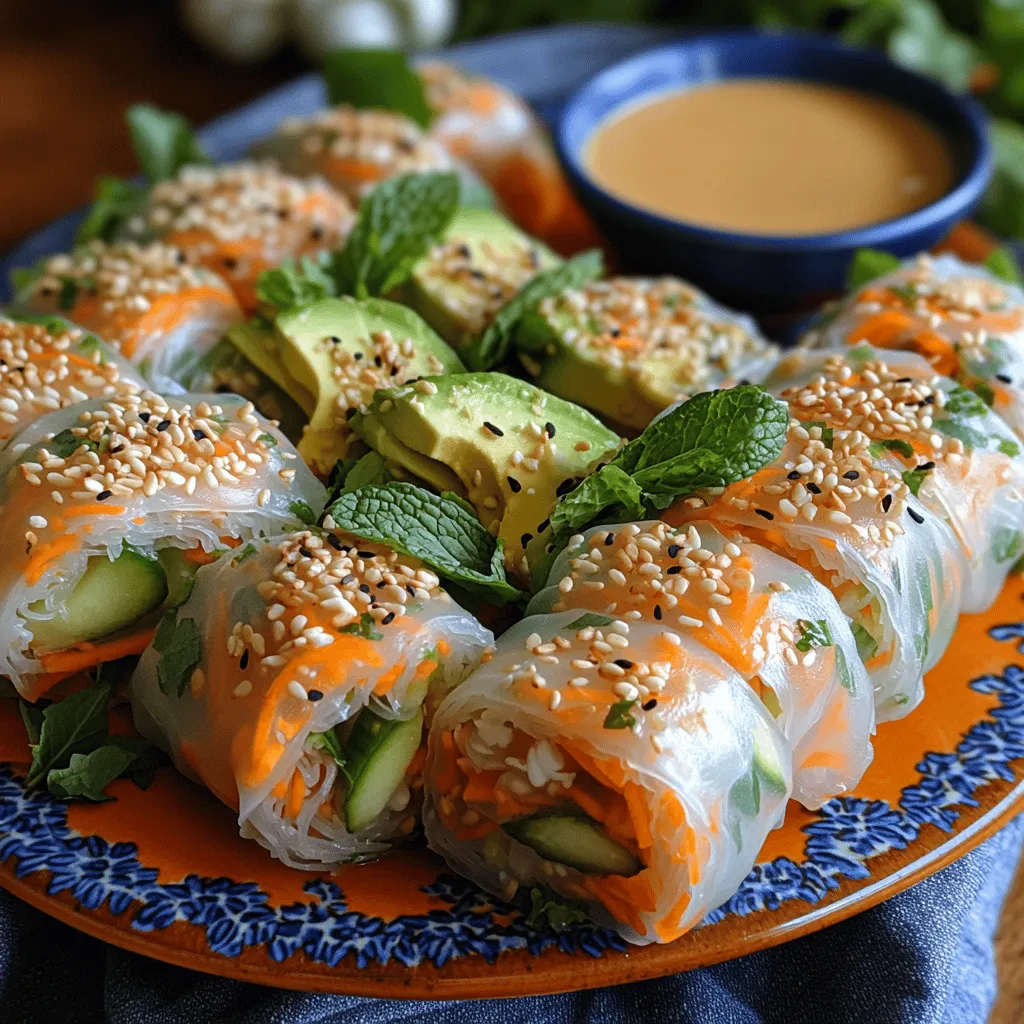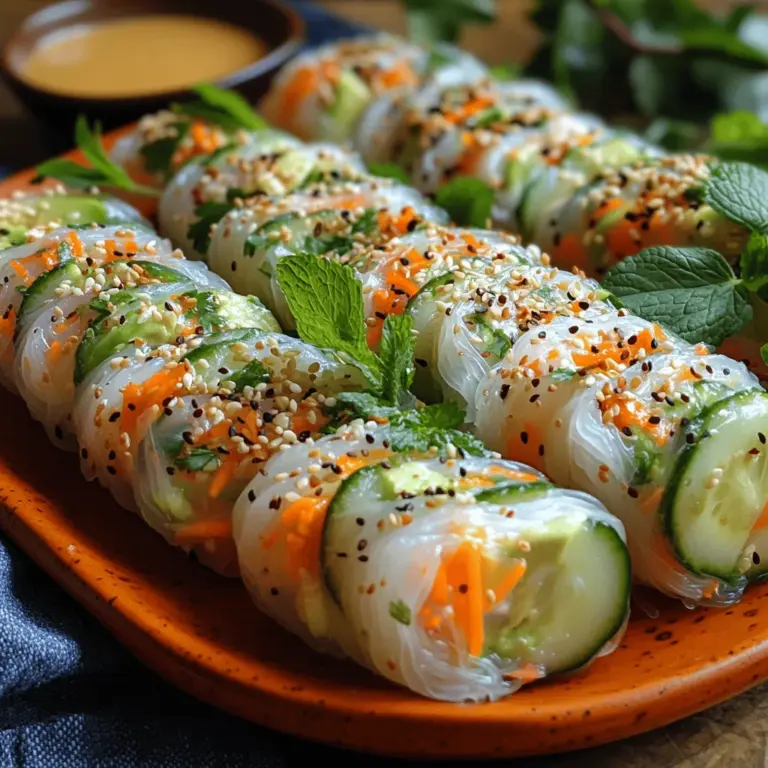Introduction
As the sun shines brighter and temperatures rise, the craving for light and refreshing meals becomes almost irresistible. One dish that perfectly embodies the spirit of summer is the vibrant and delightful rice paper rolls. These fresh and crunchy summer veggie rice paper rolls are not only visually appealing but also a celebration of the season’s bounty, packed with a variety of colorful vegetables and herbs. The combination of textures and flavors in each bite makes them a popular choice for those looking to indulge in something both satisfying and healthy.
The key to enjoying rice paper rolls lies in the use of fresh, high-quality ingredients. In a world where processed foods are prevalent, turning to fresh vegetables and herbs can make a significant difference in the taste and nutritional value of your meals. Rice paper rolls are an excellent example of how simple ingredients can come together to create a dish that is both nutritious and delicious. They offer a versatile canvas for your culinary creativity, allowing you to mix and match ingredients to suit your taste preferences or dietary needs.
While rice paper rolls are often associated with Asian cuisine, their versatility extends beyond geographical boundaries. They can be filled with an array of ingredients, making them a perfect option for a light lunch, appetizer, or even a party platter. In this article, we will explore the art of making fresh and crunchy summer veggie rice paper rolls, guiding you through the ingredients, nutritional benefits, and step-by-step preparation process that will leave you feeling inspired to whip up this delightful dish.
Understanding Rice Paper Rolls
Before diving into the preparation of our fresh veggie rice paper rolls, it’s essential to understand what rice paper is and how it can be utilized in various cuisines. Rice paper, often made from a mixture of rice flour, water, and salt, is a thin, translucent wrapper that is commonly used in Asian cooking, particularly in Vietnamese and Thai dishes. The texture of rice paper is uniquely delicate yet sturdy enough to hold an array of fillings, making it an ideal choice for both fresh and fried preparations.
Rice paper rolls differ significantly from traditional spring rolls, which are usually deep-fried and often filled with meat or seafood. In contrast, fresh rice paper rolls are served cold and filled with a variety of fresh vegetables, herbs, and sometimes protein sources like tofu or shrimp. This not only makes them a lighter option but also allows the natural flavors of the fresh ingredients to shine through. Nutritionally, rice paper rolls are a fantastic choice for those looking to incorporate more vegetables into their diet, as they are low in calories and fat while providing essential vitamins and minerals.
In addition to being a healthy meal option, rice paper rolls are incredibly versatile. You can customize the fillings to suit your preferences or to use up leftover vegetables in your fridge. They can be enjoyed on their own, paired with a dipping sauce, or served as part of a larger meal. The possibilities are endless, making rice paper rolls a staple in many modern kitchens.
Ingredients Breakdown
Now that we’ve established the appeal and versatility of rice paper rolls, let’s break down the ingredients that will make our fresh and crunchy summer veggie rice paper rolls truly shine. Each component plays a crucial role in contributing to the overall flavor, texture, and nutritional profile of the dish.
Rice Paper Wrappers
The foundation of our rice paper rolls is, of course, the rice paper wrappers themselves. These thin sheets bring a delicate texture and a neutral flavor that allows the vibrant fillings to take center stage. When selecting rice paper, look for high-quality brands that offer a smooth and pliable texture. Properly hydrated rice paper will make the rolling process easier and result in a more visually appealing roll.
Vermicelli Rice Noodles
To provide a hearty base, we will include vermicelli rice noodles in our rolls. These thin noodles, made from rice flour, add a satisfying chewiness that complements the crisp vegetables. Not only do they help to fill out the rolls, but they also absorb the flavors of the ingredients around them. When cooked properly, vermicelli noodles become a delightful addition, enhancing both texture and taste.
Fresh Vegetables
The heart of our summer veggie rice paper rolls lies in the fresh vegetables. A colorful medley will not only make your rolls visually appealing but also provide a range of nutrients. Here are some key vegetables to include:
– Carrots: Shredded or julienned carrots add a sweet crunch and are rich in beta-carotene, which is beneficial for eye health.
– Cucumber: Thinly sliced cucumber contributes a refreshing crispness and is hydrating, perfect for a summer dish.
– Red Bell Pepper: The sweetness and vibrant color of red bell peppers not only enhance the dish aesthetically but also provide a good source of vitamin C.
These vegetables can be mixed and matched according to your preferences and what’s in season, allowing for endless creativity.
Avocado
Adding avocado to your rice paper rolls brings a creamy element that balances the crispness of the vegetables. Avocado is known for its healthy fats, particularly monounsaturated fats, which are beneficial for heart health. Its rich texture also helps to create a more satisfying bite, making these rolls feel indulgent without being heavy.
Herbs
To elevate the flavor profile of your rice paper rolls, fresh herbs are a must. Mint and cilantro are excellent choices, as they provide a burst of freshness that complements the other ingredients beautifully. Mint adds a cooling effect, which is especially refreshing on a hot day, while cilantro brings a hint of earthiness that ties the flavors together.
Bean Sprouts
Bean sprouts are a fantastic addition to rice paper rolls, contributing an extra layer of crunch and nutrition. They are low in calories but high in vitamins and minerals, making them a great choice for anyone looking to boost their vegetable intake. Their mild flavor allows them to blend seamlessly with other ingredients without overpowering them.
Scallions and Sesame Seeds
Finally, scallions and sesame seeds serve as finishing touches that enhance both flavor and presentation. Scallions add a subtle oniony flavor that complements the freshness of the vegetables, while sesame seeds offer a nutty crunch that rounds out the texture of the rolls.
Overview of the Peanut Dipping Sauce Ingredients
No rice paper roll is complete without a delicious dipping sauce. A classic peanut dipping sauce typically includes ingredients such as peanut butter, soy sauce, lime juice, and a touch of sweetener. This sauce not only provides a rich and creamy contrast to the fresh rolls but also brings an additional layer of flavor that ties the dish together. The combination of salty, sweet, and tangy notes makes it a perfect accompaniment.
In the following sections, we will delve into the step-by-step instructions for preparing these delightful fresh and crunchy summer veggie rice paper rolls, ensuring you achieve the best texture and flavor in every bite. But first, let’s focus on the preparation of the fresh vegetables, which is crucial for achieving the desired taste and presentation.
Step-by-Step Instructions
Preparing the Fresh Vegetables
The first step in making fresh veggie rice paper rolls is preparing the vegetables. This process is essential not only for flavor but also for ensuring that your rolls hold together well and look aesthetically pleasing.
1. Washing: Begin by thoroughly washing all your fresh vegetables. This step is crucial, as it removes any dirt or pesticide residues. Use cold water for rinsing and gently scrub the surfaces of the vegetables, especially those that are thicker-skinned, like cucumbers.
2. Cutting Techniques: Once washed, it’s time to cut the vegetables. The way you cut your vegetables can greatly influence the final look and feel of your rice paper rolls.
– Carrots: For carrots, you can either julienne them into thin matchstick-like strips or grate them for a finer texture. Both methods will give a nice crunch and sweetness to the rolls.
– Cucumber: Slice the cucumber in half lengthwise, then scoop out the seeds with a spoon. This will prevent excess moisture from making your rolls soggy. Cut the cucumber into thin strips or half-moons for easy rolling.
– Red Bell Pepper: Remove the seeds and stem from the red bell pepper, then slice it into thin strips. The bright color and sweet flavor will add vibrancy to your rolls.
3. Avocado: When it comes to avocado, slice it in half, remove the pit, and scoop out the flesh with a spoon. Cut the avocado into thin slices or cubes, depending on your preference. Be cautious when handling avocado, as it can brown quickly; a squeeze of lime juice can help preserve its color.
4. Herbs: Finally, prepare your fresh herbs by rinsing them under cold water and patting them dry with a clean towel. Remove any tough stems and roughly chop the mint and cilantro, keeping in mind that these will add a significant punch of flavor to your rolls.
These initial steps of washing and cutting are critical in achieving the best texture and flavor for your fresh veggie rice paper rolls.
In the next part of this article, we will explore the detailed step-by-step instructions for rolling your rice paper rolls, including tips for achieving the perfect roll and ensuring that the ingredients stay intact and flavorful. Stay tuned for the exciting continuation!

Cooking the Vermicelli Rice Noodles
Cooking vermicelli rice noodles is a crucial step in preparing Fresh & Crunchy Summer Veggie Rice Paper Rolls. These delicate noodles provide the perfect texture and absorb the flavors of the fresh vegetables and dipping sauce.
Detailed Cooking Instructions for Perfect Noodles
1. Boil Water: Fill a medium-sized pot with water and bring it to a rolling boil. Use enough water to allow the noodles to move freely.
2. Add Noodles: Once the water is boiling, add the vermicelli rice noodles. Stir gently to separate the strands.
3. Cook Time: Allow the noodles to boil for about 3-5 minutes, or until they are just tender but still slightly firm to the bite. Avoid overcooking, as they can become mushy.
4. Drain and Rinse: After cooking, immediately drain the noodles in a colander and rinse them under cold running water. This stops the cooking process and helps to remove excess starch.
5. Cool Down: Let the noodles cool completely. This is essential as it prevents the noodles from becoming sticky when you assemble the rolls.
Importance of Rinsing and Cooling
Rinsing the vermicelli noodles is crucial for achieving the right texture. It removes any excess starch that can cause the noodles to clump together. Cooling them also ensures they maintain their structure during the assembly of the rice paper rolls, making it easier to roll and handle.
Crafting the Peanut Dipping Sauce
A smooth and creamy peanut dipping sauce perfectly complements the Fresh & Crunchy Summer Veggie Rice Paper Rolls. Here’s how to make it.
Step-by-Step Guide to Achieving a Smooth and Creamy Sauce
1. Gather Ingredients: You will need:
– 1/2 cup of creamy peanut butter
– 2 tablespoons of soy sauce (or tamari for gluten-free)
– 1 tablespoon of rice vinegar
– 2 tablespoons of maple syrup or honey
– 1-2 teaspoons of chili paste (adjust to your heat preference)
– Water to thin, as needed
2. Mix Ingredients: In a medium bowl, add the peanut butter, soy sauce, rice vinegar, maple syrup, and chili paste. Stir with a whisk or a fork until well combined.
3. Adjust Consistency: Gradually add water, one tablespoon at a time, mixing until the sauce reaches your desired consistency. It should be smooth and pourable but not too runny.
4. Taste and Adjust Seasoning: Taste the sauce and adjust the seasoning as needed. If you want it spicier, add more chili paste; for sweetness, add more maple syrup or honey.
Soaking and Assembling the Rice Paper Rolls
The key to perfect rice paper rolls lies in the soaking technique and the assembly process.
Techniques for Soaking Rice Paper Without Tearing
1. Prepare a Shallow Dish: Fill a shallow dish or a large plate with warm water. Ensure the water is not too hot; lukewarm is ideal.
2. Soak the Rice Paper: Take one rice paper sheet and dip it into the warm water. Soak for about 10-15 seconds, or until it becomes soft and pliable. Do not soak for too long, as it can become too fragile and tear easily.
3. Shake Off Excess Water: Gently shake off any excess water before placing it on a clean, damp surface or a cutting board.
Detailed Assembly Process for Perfect Rolls
1. Lay Out Ingredients: Arrange your prepared ingredients, including the cooled vermicelli noodles, fresh herbs, and sliced vegetables within reach.
2. Add Ingredients: Place a small amount of vermicelli noodles (about a handful), a few slices of cucumber, bell pepper, carrots, and a few fresh herbs (like mint and cilantro) onto the lower third of the rice paper.
3. Roll it Up: Starting from the bottom, fold the rice paper over the filling. Tuck the sides in and continue to roll tightly, making sure the filling is secure but not overly packed.
4. Repeat Process: Continue the process with the remaining rice paper sheets and fillings.
Creative Ideas for Additional Fillings and Variations
Feel free to experiment with different fillings to suit your taste or dietary needs. Some creative ideas include:
– Protein Additions: Add tofu, shrimp, or shredded chicken for extra protein.
– Fruits: Incorporate slices of mango, avocado, or pineapple for a sweet twist.
– Nuts and Seeds: Sprinkle in some toasted sesame seeds or chopped peanuts for added crunch.
Rolling Techniques
Rolling rice paper rolls may take a little practice, but with these tips, you’ll master it in no time.
Tips for Rolling Tightly Without Breaking the Wrapper
1. Avoid Overstuffing: Less is more when it comes to filling. Overstuffed rolls are more prone to breaking.
2. Use a Damp Surface: Rolling on a damp surface helps prevent the rice paper from sticking.
3. Practice Makes Perfect: Don’t worry if the first few rolls don’t look perfect. With practice, you’ll find the right technique for your desired roll shape.
Visual Cues for Knowing When the Rolls are Ready
The rolls should be firm yet flexible. If they feel too soft or are tearing, you may have soaked the rice paper for too long. When rolled, they should hold together but still be pliable enough to bend without breaking.
Serving Suggestions
Presentation can elevate your dish. Here are some tips for serving your Fresh & Crunchy Summer Veggie Rice Paper Rolls.
Ideal Serving Platters and Presentation Tips
– Serve on a Colorful Platter: Arrange the rice paper rolls on a vibrant platter to enhance their visual appeal. Consider using a white plate to make the colors of the rolls pop.
– Garnish: Add a sprinkle of sesame seeds or chopped peanuts on top of the rolls for added texture.
– Serve with Dipping Sauce: Place the peanut dipping sauce in a small bowl in the center of the platter for an inviting presentation.
Pairing Ideas with Drinks or Other Dishes for a Complete Meal
These rice paper rolls pair well with a variety of beverages. Consider serving with:
– Herbal Iced Tea: A refreshing herbal iced tea complements the lightness of the rolls.
– Coconut Water: The sweetness of coconut water balances the savory flavor of the rolls.
For a complete meal, serve alongside:
– Vietnamese Pho: A warming bowl of pho complements the freshness of the rolls.
– Thai Green Curry: The spicy, rich flavors of curry contrast beautifully with the fresh veggies.
Suggestions for Dipping Sauce Variations and Alternatives
If you want to mix it up, consider trying different dipping sauces:
– Sweet Chili Sauce: Add a sweet and spicy kick.
– Hoisin Sauce: For a thicker and sweeter alternative.
– Soy Sauce with Lime: A simple and tangy option.
Nutritional Information
Understanding the nutritional aspects of your Fresh & Crunchy Summer Veggie Rice Paper Rolls can help you appreciate their health benefits.
Breakdown of Nutritional Values Per Serving
While the exact values can vary based on specific ingredients and portion sizes, a typical serving (two rolls) may contain approximately:
– Calories: 150-200
– Protein: 6-8 grams
– Carbohydrates: 30-35 grams
– Fats: 5-8 grams
– Fiber: 3-4 grams
Health Benefits of the Ingredients Used
– Fresh Vegetables: Rich in vitamins, minerals, and antioxidants, contributing to overall health.
– Rice Noodles: A gluten-free option, providing easily digestible carbohydrates.
– Peanut Butter: Offers healthy fats and protein, promoting satiety.
Dietary Considerations (Vegan, Gluten-Free Options)
This recipe is naturally vegan and can easily be made gluten-free by using gluten-free soy sauce or tamari. Always ensure that the rice paper and other sauces align with dietary preferences.
Conclusion
Fresh & Crunchy Summer Veggie Rice Paper Rolls are not only a delightful addition to your meal but also a versatile dish that allows for endless creativity. They are packed with fresh ingredients, making them a healthy choice for any occasion. The process of making these rolls is not only straightforward but also a fun way to experiment with flavors and textures.
I encourage you to try making these rolls at home. Don’t hesitate to experiment with different fillings, sauces, and presentation styles to create a dish that reflects your taste. With a bit of practice, you’ll be rolling up these delicious rice paper rolls like a pro, impressing friends and family alike with your culinary skills!


